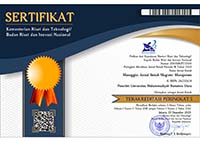Strategi Pemasaran Kelapa Sawit Melalui Pendekatan Analisis Structure Conduct And Performance (SCP) di Kabupaten Simalungun
Abstract
The purpose of this study was to determine the marketing strategy of palm oil using a structure, behavior and marketing performance approach to: (1) Analyze the market structure of the palm oil industry in Tanah Jawa District, Simalungun Regency. (2) Analyzing the marketing function so that it is known the behavior of the palm oil market in Tanah Jawa District, Simalungun Regency. (3) Analyzing the margin and farmer share so that the performance of the palm oil industry is known in the Tanah Jawa District of Simalungun Regency. (4) Analysis of the relationship between the structure, behavior and performance of the palm oil industry in Tanah Jawa District, Simalungun Regency. The analytical method used in this research is marketing channel analysis and market structure analysis which is seen from market concentration and market entry barriers. Analysis of market behavior seen from the marketing function, namely the exchange function, physical function and facility functions. Analysis of market performance seen from the farmer share and marketing margin.
Based on the results of research conducted, the market structure of the palm oil industry in Tanah Jawa District, Simalungun District is an imperfect competition market that is oligopolistic, with an average market concentration of 83 percent. This means that the market structure in Kecamatan Tanah Jawa is grouped in strict oligopoly and the average barriers to market entry are 9 percent, so there is no obstacle to enter the market in Tanah Jawa District, Simalungun Regency. Market behavior in the palm oil industry in Tanah Jawa District, Simalungun District can be seen from the pricing strategy and product strategy. The price strategy is carried out by collusion between market participants, namely making the highest production costs in consideration of sales prices. Product strategy is done by classifying products based on size, price and product quality. There are several marketing institutions, namely farmers, small agents, large agents, factories. Each marketing agency performs marketing functions. In marketing activities the existence of capital ties by farmers with small agents and large agents causes contractual ties.
Market performance analysis (Market Performance) of palm oil in Tanah Java District, Simalungun District shows that there are 3 marketing channels with different margins. The highest total margin is found in marketing channel III, which is 34.06 percent, the more marketing institutions involved, the higher the marketing margin and the lower farmer share. The most efficient marketing channel is the marketing channel I (farmer-factory).
Keywords
Full Text:
PDFReferences
[BPS] Badan Pusat Statistik. 2015. Statistik Kelapa Sawit Indonesia. Medan.
Dahl DC, Hammond JW. 1977. Market and Price Analysis. Mc. Graw Hill, New York.
Jaya, W.K. 2001. Ekonomi Industri. BPFE, Yogyakarta.
Kohls RL, Downey WD. 1972. Marketing of Agricultural Products 4th edition. Macmillan Publishing. New York.
Sinaga et al. 2014. Fluktuasi Harga pada Produk Pertanian. Yogyakarta.
Sitorus, A.S. 2012. Analisis Struktur, Perilaku, Dan Kinerja Industri Kakao Di Indonesia. Departemen Manajemen. Fakultas Ekonomi dan Manajemen. Institut Pertanian Bogor.
DOI: https://doi.org/10.30596/jasc.v2i1.2498
Refbacks
- There are currently no refbacks.
JASc (Journal of Agribusiness Sciences)
Fakultas Pertanian Universitas Muhammadiyah Sumatera Utara
Kampus Utama
Jl. Kapten Muchtar Basri No.3, Glugur Darat II,Medan
Sumatera Utara-20238
E-mail: jasc@umsu.ac.id
This work is licensed under a Creative Commons Attribution-ShareAlike 4.0 International License.
View My Stats






